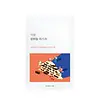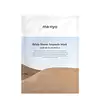What's inside
What's inside
 Key Ingredients
Key Ingredients

 Benefits
Benefits

 Concerns
Concerns

 Ingredients Side-by-side
Ingredients Side-by-side

Water
Skin ConditioningGlycerin
HumectantButylene Glycol
HumectantDipropylene Glycol
HumectantGlycine Max Seed Extract
Skin ConditioningPanthenol
Skin ConditioningCeramide NP
Skin ConditioningCholesterol
EmollientBrassica Campestris Sterols
EmollientOleic Acid
EmollientStearic Acid
CleansingCeramide AP
Skin ConditioningSorbitan Olivate
EmulsifyingAcrylates/C10-30 Alkyl Acrylate Crosspolymer
Emulsion StabilisingHydroxyethyl Acrylate/Sodium Acryloyldimethyl Taurate Copolymer
Emulsion StabilisingPolyurethane-15
Xanthan Gum
EmulsifyingSorbitan Isostearate
EmulsifyingGlyceryl Stearate Se
EmulsifyingBetaine
Humectant1,2-Hexanediol
Skin ConditioningCetearyl Olivate
Squalane
EmollientCaprylic/Capric Triglyceride
MaskingAllantoin
Skin ConditioningArginine
MaskingAdenosine
Skin ConditioningHydrogenated Lecithin
EmulsifyingPentylene Glycol
Skin ConditioningCetyl Ethylhexanoate
EmollientMacadamia Ternifolia Seed Oil
EmollientTocopherol
AntioxidantAcetylphytosphingosine
Skin ConditioningGlyceryl Stearate Citrate
EmollientSodium Surfactin
CleansingPhytosphingosine
Skin ConditioningTetraacetylphytosphingosine
Skin ConditioningHydroxyacetophenone
AntioxidantEthylhexylglycerin
Skin ConditioningDisodium EDTA
Water, Glycerin, Butylene Glycol, Dipropylene Glycol, Glycine Max Seed Extract, Panthenol, Ceramide NP, Cholesterol, Brassica Campestris Sterols, Oleic Acid, Stearic Acid, Ceramide AP, Sorbitan Olivate, Acrylates/C10-30 Alkyl Acrylate Crosspolymer, Hydroxyethyl Acrylate/Sodium Acryloyldimethyl Taurate Copolymer, Polyurethane-15, Xanthan Gum, Sorbitan Isostearate, Glyceryl Stearate Se, Betaine, 1,2-Hexanediol, Cetearyl Olivate, Squalane, Caprylic/Capric Triglyceride, Allantoin, Arginine, Adenosine, Hydrogenated Lecithin, Pentylene Glycol, Cetyl Ethylhexanoate, Macadamia Ternifolia Seed Oil, Tocopherol, Acetylphytosphingosine, Glyceryl Stearate Citrate, Sodium Surfactin, Phytosphingosine, Tetraacetylphytosphingosine, Hydroxyacetophenone, Ethylhexylglycerin, Disodium EDTA
Water
Skin ConditioningMethylpropanediol
Solvent1,2-Hexanediol
Skin ConditioningGlycerin
HumectantNiacinamide
SmoothingButylene Glycol
HumectantBifida Ferment Lysate
Skin ConditioningLactobacillus Ferment Lysate
Skin ConditioningLactococcus Ferment Lysate
Skin ConditioningSaccharomyces Ferment Filtrate
HumectantLactobacillus Ferment
Skin ConditioningChrysanthemum Zawadskii Extract
Skin ConditioningGlycyrrhiza Uralensis Root Extract
Skin ConditioningAnastatica Hierochuntica Extract
AstringentArtemisia Capillaris Extract
Hamamelis Virginiana Water
AstringentHyaluronic Acid
HumectantHydrolyzed Hyaluronic Acid
HumectantSodium Hyaluronate
HumectantCeramide NP
Skin ConditioningPanthenol
Skin ConditioningLeonurus Sibiricus Extract
Skin ConditioningPaeonia Albiflora Flower Extract
TonicHydroxyethyl Urea
HumectantTromethamine
BufferingCynanchum Atratum Extract
Skin ConditioningOenothera Biennis Flower Extract
AstringentMadecassoside
AntioxidantIsoleucine
Skin ConditioningHistidine
HumectantCysteine
AntioxidantCyperus Rotundus Root Extract
Skin ConditioningAspartic Acid
MaskingAllantoin
Skin ConditioningDextrin
AbsorbentSodium Phytate
Propanediol
SolventGlycine
BufferingSerine
MaskingGlutamic Acid
HumectantTheobroma Cacao Seed Extract
AntioxidantAlthaea Rosea Flower Extract
Skin ConditioningEthylhexylglycerin
Skin ConditioningPolyglyceryl-10 Laurate
Skin ConditioningPolyglyceryl-10 Myristate
Skin ConditioningLeucine
Skin ConditioningAlanine
MaskingLysine
Skin ConditioningArginine
MaskingTyrosine
MaskingPhenylalanine
MaskingProline
Skin ConditioningThreonine
Valine
MaskingPinus Palustris Leaf Extract
TonicPueraria Thunbergiana Root Extract
Skin ConditioningUlmus Davidiana Root Extract
Skin ConditioningMethionine
Skin ConditioningCarbomer
Emulsion StabilisingCaffeine
Skin ConditioningXanthan Gum
EmulsifyingAdenosine
Skin ConditioningCutibacterium Granulosum Ferment Extract Filtrate
EmollientBifida Ferment Filtrate
Skin ConditioningWater, Methylpropanediol, 1,2-Hexanediol, Glycerin, Niacinamide, Butylene Glycol, Bifida Ferment Lysate, Lactobacillus Ferment Lysate, Lactococcus Ferment Lysate, Saccharomyces Ferment Filtrate, Lactobacillus Ferment, Chrysanthemum Zawadskii Extract, Glycyrrhiza Uralensis Root Extract, Anastatica Hierochuntica Extract, Artemisia Capillaris Extract, Hamamelis Virginiana Water, Hyaluronic Acid, Hydrolyzed Hyaluronic Acid, Sodium Hyaluronate, Ceramide NP, Panthenol, Leonurus Sibiricus Extract, Paeonia Albiflora Flower Extract, Hydroxyethyl Urea, Tromethamine, Cynanchum Atratum Extract, Oenothera Biennis Flower Extract, Madecassoside, Isoleucine, Histidine, Cysteine, Cyperus Rotundus Root Extract, Aspartic Acid, Allantoin, Dextrin, Sodium Phytate, Propanediol, Glycine, Serine, Glutamic Acid, Theobroma Cacao Seed Extract, Althaea Rosea Flower Extract, Ethylhexylglycerin, Polyglyceryl-10 Laurate, Polyglyceryl-10 Myristate, Leucine, Alanine, Lysine, Arginine, Tyrosine, Phenylalanine, Proline, Threonine, Valine, Pinus Palustris Leaf Extract, Pueraria Thunbergiana Root Extract, Ulmus Davidiana Root Extract, Methionine, Carbomer, Caffeine, Xanthan Gum, Adenosine, Cutibacterium Granulosum Ferment Extract Filtrate, Bifida Ferment Filtrate
 Reviews
Reviews

Ingredients Explained
These ingredients are found in both products.
Ingredients higher up in an ingredient list are typically present in a larger amount.
1,2-Hexanediol is a synthetic liquid and another multi-functional powerhouse.
It is a:
- Humectant, drawing moisture into the skin
- Emollient, helping to soften skin
- Solvent, dispersing and stabilizing formulas
- Preservative booster, enhancing the antimicrobial activity of other preservatives
Adenosine is in every living organism. It is one of four components in nucleic acids that helps store our DNA.
Adenosine has many benefits when used. These benefits include hydrating the skin, smoothing skin, and reducing wrinkles. Once applied, adenosine increases collagen production. It also helps with improving firmness and tissue repair.
Studies have found adenosine may also help with wound healing.
In skincare products, Adenosine is usually derived from yeast.
Learn more about AdenosineAllantoin is a soothing ingredient known for its protective and moisturizingg properties. Because of this, it is often added to products with strong active ingredients.
Studies show higher concentrations of this ingredient can promote wound healing.
Though it can be derived from the comfrey plant, allantoin is produced synthetically for cosmetic products to ensure purity.
Learn more about AllantoinArginine is an amino acid that is important for human development. Your body uses is it to produce hair keratin and skin collagen.
As a cosmetic ingredient, Arginine has antioxidant properties and can also help repair damaged skin. This ingredient is derived either synthetically or from animals.
Arginine isn't fungal acne safe when used in the presence of other lipids (fats, fatty acids, oils, esters, etc). Oils and fats occur naturally within the skin, so take caution when using Arginine if you're prone to fungal acne.
Learn more about ArginineButylene Glycol (or BG) is used within cosmetic products for a few different reasons:
Overall, Butylene Glycol is a safe and well-rounded ingredient that works well with other ingredients.
Though this ingredient works well with most skin types, some people with sensitive skin may experience a reaction such as allergic rashes, closed comedones, or itchiness.
Learn more about Butylene GlycolCeramide NP is a type of ceramide and formally known as ceramide 3.
Ceramides are intercellular lipids naturally found in our skin that bonds dead skin cells together to create a barrier. They are known for their ability to hold water and thus are a great ingredient for dry skin.
Ceramides are an important building block for our skin barrier. A stronger barrier helps the skin look more firm and hydrated. By bolstering the skin ceramides act as a barrier against irritating ingredients. This can help with inflammation as well.
If you would like to eat ceramides, sweet potatoes contain a small amount.
Read more about other common types of ceramides here:
Ceramide AP
Ceramide EOP
Ethylhexylglycerin (we can't pronounce this either) is commonly used as a preservative and skin softener. It is derived from glyceryl.
You might see Ethylhexylglycerin often paired with other preservatives such as phenoxyethanol. Ethylhexylglycerin has been found to increase the effectiveness of these other preservatives.
Glycerin is already naturally found in your skin. It helps moisturize and protect your skin.
A study from 2016 found glycerin to be more effective as a humectant than AHAs and hyaluronic acid.
As a humectant, it helps the skin stay hydrated by pulling moisture to your skin. The low molecular weight of glycerin allows it to pull moisture into the deeper layers of your skin.
Hydrated skin improves your skin barrier; Your skin barrier helps protect against irritants and bacteria.
Glycerin has also been found to have antimicrobial and antiviral properties. Due to these properties, glycerin is often used in wound and burn treatments.
In cosmetics, glycerin is usually derived from plants such as soybean or palm. However, it can also be sourced from animals, such as tallow or animal fat.
This ingredient is organic, colorless, odorless, and non-toxic.
Glycerin is the name for this ingredient in American English. British English uses Glycerol/Glycerine.
Learn more about GlycerinPanthenol is a common ingredient that helps hydrate and soothe the skin. It is found naturally in our skin and hair.
There are two forms of panthenol: D and L.
D-panthenol is also known as dexpanthenol. Most cosmetics use dexpanthenol or a mixture of D and L-panthenol.
Panthenol is famous due to its ability to go deeper into the skin's layers. Using this ingredient has numerous pros (and no cons):
Like hyaluronic acid, panthenol is a humectant. Humectants are able to bind and hold large amounts of water to keep skin hydrated.
This ingredient works well for wound healing. It works by increasing tissue in the wound and helps close open wounds.
Once oxidized, panthenol converts to pantothenic acid. Panthothenic acid is found in all living cells.
This ingredient is also referred to as pro-vitamin B5.
Learn more about PanthenolWater. It's the most common cosmetic ingredient of all. You'll usually see it at the top of ingredient lists, meaning that it makes up the largest part of the product.
So why is it so popular? Water most often acts as a solvent - this means that it helps dissolve other ingredients into the formulation.
You'll also recognize water as that liquid we all need to stay alive. If you see this, drink a glass of water. Stay hydrated!
Learn more about WaterXanthan gum is used as a stabilizer and thickener within cosmetic products. It helps give products a sticky, thick feeling - preventing them from being too runny.
On the technical side of things, xanthan gum is a polysaccharide - a combination consisting of multiple sugar molecules bonded together.
Xanthan gum is a pretty common and great ingredient. It is a natural, non-toxic, non-irritating ingredient that is also commonly used in food products.
Learn more about Xanthan Gum